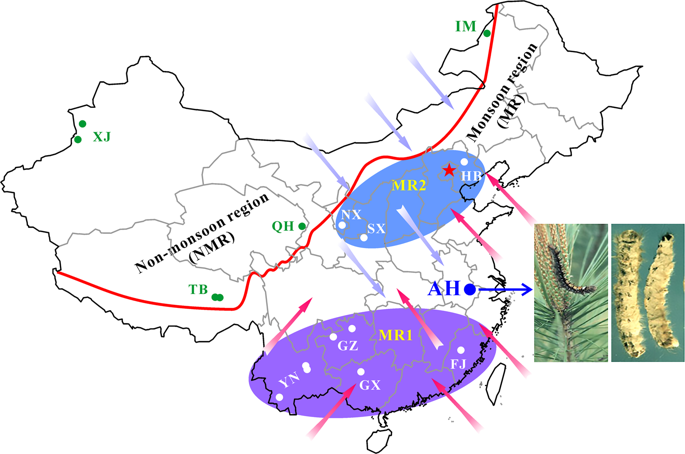Our official English website, www.x-mol.net, welcomes your
feedback! (Note: you will need to create a separate account there.)
Population genomics and evolution of a fungal pathogen after releasing exotic strains to control insect pests for 20 years.
The ISME Journal ( IF 10.8 ) Pub Date : 2020-02-28 , DOI: 10.1038/s41396-020-0620-8 Lijuan Mei 1, 2 , Mingjun Chen 3 , Yanfang Shang 1 , Guirong Tang 1 , Ye Tao 4 , Liang Zeng 4 , Bo Huang 3 , Zengzhi Li 3 , Shuai Zhan 1 , Chengshu Wang 1, 2, 5
The ISME Journal ( IF 10.8 ) Pub Date : 2020-02-28 , DOI: 10.1038/s41396-020-0620-8 Lijuan Mei 1, 2 , Mingjun Chen 3 , Yanfang Shang 1 , Guirong Tang 1 , Ye Tao 4 , Liang Zeng 4 , Bo Huang 3 , Zengzhi Li 3 , Shuai Zhan 1 , Chengshu Wang 1, 2, 5
Affiliation

|
Entomopathogenic fungi are one of the key regulators of insect populations in nature. Some species such as Beauveria bassiana with a wide host range have been developed as promising alternatives to chemical insecticides for the biocontrol of insect pests. However, the long-term persistence of the released strains, the effect on non-target hosts and local fungal populations remains elusive, but they are considerable concerns with respect to environmental safety. Here we report the temporal features of the Beauveria population genomics and evolution over 20 years after releasing exotic strains to control pine caterpillar pests. We found that the isolates within the biocontrol site were mostly of clonal origins. The released strains could persist in the environment for a long time but with low recovery rates. Similar to the reoccurrence of host jumping by local isolates, the infection of non-target insects by the released strains was evident to endemically occur in association with host seasonality. No obvious dilution effect on local population structure was evident by the releases. However, the population was largely replaced by genetically divergent isolates once per decade but evolved with a pattern of balancing selection and towards expansion through adaptation, non-random outcrossing and isolate migration. This study not only unveils the real-time features of entomopathogenic fungal population genomics and evolution but also provides added values to alleviate the concerns of environmental safety regarding the biocontrol application of mycoinsecticides.
中文翻译:

释放外来菌株控制害虫 20 年后真菌病原体的种群基因组学和进化。
昆虫病原真菌是自然界昆虫种群的关键调节因子之一。一些物种,例如具有广泛宿主范围的白僵菌,已被开发为用于生物防治害虫的化学杀虫剂的有希望的替代品。然而,释放菌株的长期持续性,对非目标宿主和当地真菌种群的影响仍然难以捉摸,但它们在环境安全方面是相当令人担忧的。在这里,我们报告了白僵菌种群基因组学的时间特征和在释放外来菌株以控制松毛虫害虫后 20 年的进化。我们发现生防站点内的分离株大多是克隆来源的。释放的菌株可以在环境中存在很长时间,但恢复率很低。与本地分离株再次发生宿主跳跃相似,释放的菌株对非目标昆虫的感染显然与宿主季节性有关。释放对当地人口结构没有明显的稀释作用。然而,种群在很大程度上被遗传上不同的分离株取代,每十年一次,但以平衡选择的模式进化,并通过适应、非随机异交和分离株迁移来扩大。该研究不仅揭示了昆虫病原真菌种群基因组学和进化的实时特征,而且为减轻对真菌杀虫剂生物防治应用的环境安全问题提供了附加价值。释放的菌株对非目标昆虫的感染显然与宿主季节性有关。释放对当地人口结构没有明显的稀释作用。然而,种群在很大程度上被遗传上不同的分离株取代,每十年一次,但以平衡选择的模式进化,并通过适应、非随机异交和分离株迁移来扩大。该研究不仅揭示了昆虫病原真菌种群基因组学和进化的实时特征,而且为减轻对真菌杀虫剂生物防治应用的环境安全问题提供了附加价值。释放的菌株对非目标昆虫的感染显然与宿主季节性有关。释放对当地人口结构没有明显的稀释作用。然而,种群在很大程度上被遗传上不同的分离株取代,每十年一次,但以平衡选择的模式进化,并通过适应、非随机异交和分离株迁移来扩大。该研究不仅揭示了昆虫病原真菌种群基因组学和进化的实时特征,而且为减轻对真菌杀虫剂生物防治应用的环境安全问题提供了附加价值。种群在很大程度上被遗传上不同的分离株每十年一次所取代,但进化为一种平衡选择的模式,并通过适应、非随机异交和分离迁移来实现扩张。该研究不仅揭示了昆虫病原真菌种群基因组学和进化的实时特征,而且为减轻对真菌杀虫剂生物防治应用的环境安全问题提供了附加价值。种群在很大程度上被遗传上不同的分离株每十年一次所取代,但进化为一种平衡选择的模式,并通过适应、非随机异交和分离迁移来实现扩张。该研究不仅揭示了昆虫病原真菌种群基因组学和进化的实时特征,而且为减轻对真菌杀虫剂生物防治应用的环境安全问题提供了附加价值。
更新日期:2020-02-28
中文翻译:

释放外来菌株控制害虫 20 年后真菌病原体的种群基因组学和进化。
昆虫病原真菌是自然界昆虫种群的关键调节因子之一。一些物种,例如具有广泛宿主范围的白僵菌,已被开发为用于生物防治害虫的化学杀虫剂的有希望的替代品。然而,释放菌株的长期持续性,对非目标宿主和当地真菌种群的影响仍然难以捉摸,但它们在环境安全方面是相当令人担忧的。在这里,我们报告了白僵菌种群基因组学的时间特征和在释放外来菌株以控制松毛虫害虫后 20 年的进化。我们发现生防站点内的分离株大多是克隆来源的。释放的菌株可以在环境中存在很长时间,但恢复率很低。与本地分离株再次发生宿主跳跃相似,释放的菌株对非目标昆虫的感染显然与宿主季节性有关。释放对当地人口结构没有明显的稀释作用。然而,种群在很大程度上被遗传上不同的分离株取代,每十年一次,但以平衡选择的模式进化,并通过适应、非随机异交和分离株迁移来扩大。该研究不仅揭示了昆虫病原真菌种群基因组学和进化的实时特征,而且为减轻对真菌杀虫剂生物防治应用的环境安全问题提供了附加价值。释放的菌株对非目标昆虫的感染显然与宿主季节性有关。释放对当地人口结构没有明显的稀释作用。然而,种群在很大程度上被遗传上不同的分离株取代,每十年一次,但以平衡选择的模式进化,并通过适应、非随机异交和分离株迁移来扩大。该研究不仅揭示了昆虫病原真菌种群基因组学和进化的实时特征,而且为减轻对真菌杀虫剂生物防治应用的环境安全问题提供了附加价值。释放的菌株对非目标昆虫的感染显然与宿主季节性有关。释放对当地人口结构没有明显的稀释作用。然而,种群在很大程度上被遗传上不同的分离株取代,每十年一次,但以平衡选择的模式进化,并通过适应、非随机异交和分离株迁移来扩大。该研究不仅揭示了昆虫病原真菌种群基因组学和进化的实时特征,而且为减轻对真菌杀虫剂生物防治应用的环境安全问题提供了附加价值。种群在很大程度上被遗传上不同的分离株每十年一次所取代,但进化为一种平衡选择的模式,并通过适应、非随机异交和分离迁移来实现扩张。该研究不仅揭示了昆虫病原真菌种群基因组学和进化的实时特征,而且为减轻对真菌杀虫剂生物防治应用的环境安全问题提供了附加价值。种群在很大程度上被遗传上不同的分离株每十年一次所取代,但进化为一种平衡选择的模式,并通过适应、非随机异交和分离迁移来实现扩张。该研究不仅揭示了昆虫病原真菌种群基因组学和进化的实时特征,而且为减轻对真菌杀虫剂生物防治应用的环境安全问题提供了附加价值。











































 京公网安备 11010802027423号
京公网安备 11010802027423号